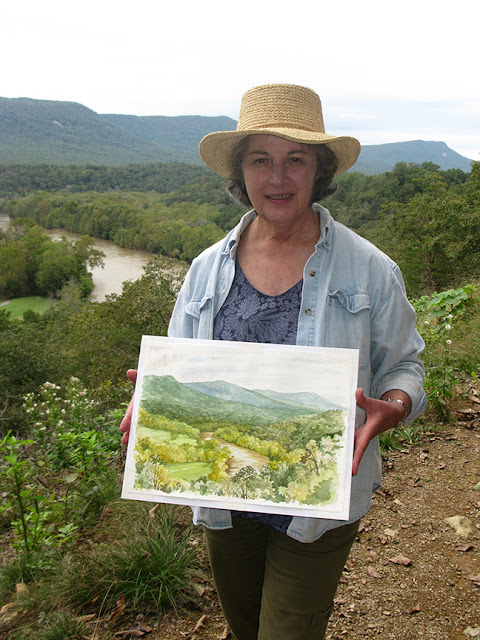 |
| Magnolia Seed Pod. |
Back in October I had the opportunity to take John Pastoriza Pinol's workshop at Brookside Gardens, and I've been looking forward to sharing what I learned. John is a superb botanical artist who shares the distinction of also being a botanist, and he really knows his stuff.
First, he shared some tips for drawing accurately, focusing on the natural geometry that seed pods and leaves follow regardless of the species, and other botanical features such as leaf veins. Most seeds and pine cones are arranged in a way that follows the Fibonacci mathematical sequence that yields a spiral. How to foreshorten these structures to create a sense of 3-dimensional perspective is always a challenge.
 |
| John Pastoriza Pinol at Brookside Gardens workshop. |
 |
| Explaining natural geometries. |
Another technique new to me was the use of masking fluid, and applying it with a calligraphy pen. I had used masking fluid on a watercolor landscape years before, but I had used a brush (ruining it in the process), and the process seemed so complicated, it hardly seemed worth the time and effort.
John's technique is to mask most of the lines of a drawing, including the outer edges, in order to leave very fine lines on the white paper, something that would be impossible to accomplish with just a brush and washes. Interestingly, this only works on Arches paper, and John explained that this manufacturer uses several layers of cotton fibers sandwiched between layers of sizing. Other watercolor paper manufacturers use only two layers of fiber with a layer of sizing in the middle, so if one applies masking fluid to those papers, the masking fluid will take off bits of fibers from the upper layer when it is removed, weakening the paper on the painted side.
Brookside Gardens had provided us a variety of interesting seed pods and leaves to work with, but I had brought a Magnolia seed pod that I'd picked a few years before that had dried into a very interesting state of disarray, and decided I'd stick with that.
 |
| Photo of my Magnolia seed pod. |
Drawing this seed pod was a challenge, and putting masking fluid over the complicated line work, even more so. Once the masking fluid had dried, I was ready to start painting with very pale washes: Vanadium Yellow first, in the area immediately surrounding the highlights that were to be left white, which John referred to as the areas of "moon-glow." After this wash had completely dried, it was followed by a wash of Perylene Red in the areas of body color, and after that dried, a wash of Cerulean Blue Hue for the shadow areas. As you can see, these pigments are very transparent, barely visible here. This was as far as I got on the second day.
 |
| Step 1: pale washed in primary colors. |
On the last day of the workshop, stronger color was introduced: first a wash of Quinacridone Gold, then a chestnut color mixed from Quinacridone Gold with a bit of Perylene Red. When that was thoroughly dry, the mask was removed. We didn't have much more time, but John demonstrated how to begin the soften the edges of the masked lines to give the illusion of depth with a damp stiff-bristled brush called a Cosmotop spin. This works well with leaf veins also. The idea is to use a drier brush with each successive layer to build up the colors in a painting.
 |
| Step 2: gold and chestnut washes. |
I wish the workshop had lasted a few more days, so that I could have learned ways to further refine my piece. As it was, I worked on it in the following weeks, gradually building up the darker colors layer by layer until getting what you see at the top of this post. I'm not sure it's quite finished yet--I may add a seed falling off or a fallen seed or two to the composition.











































